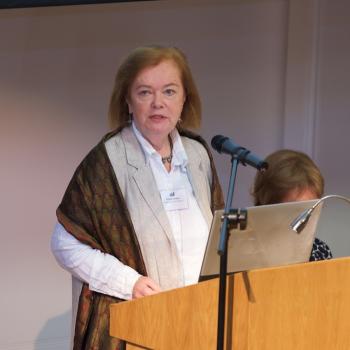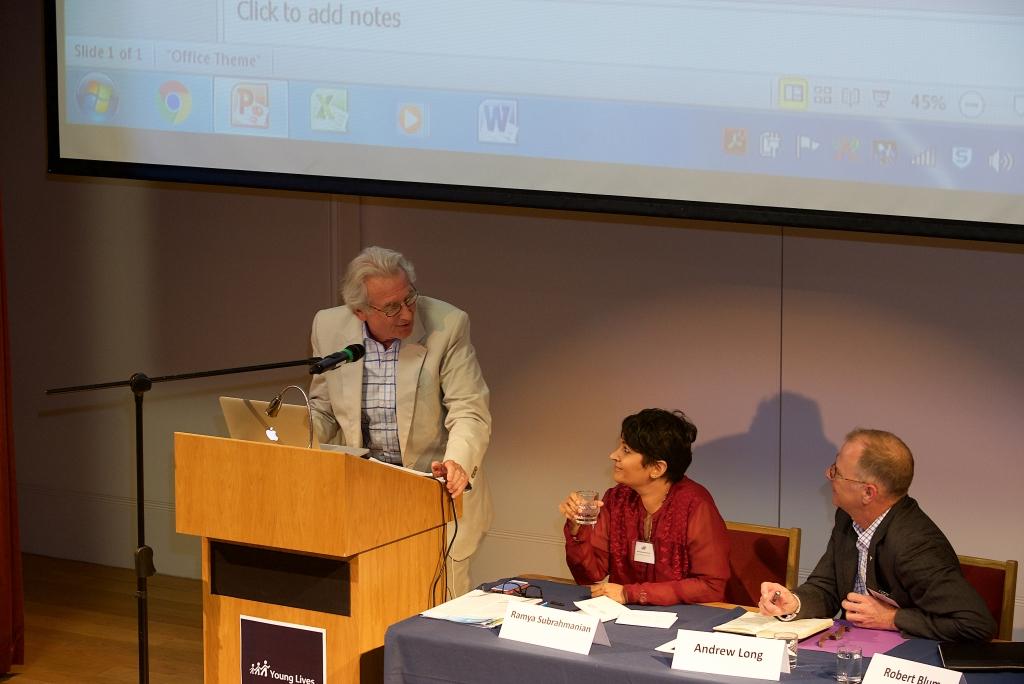
Today I spoke in London at a forum hosted by CIFAR, the Canadian Institute for Advanced Research. The multi-sectoral forum on the well-being of the world’s children is aimed at bringing researchers, practitioners and policy makers to the table to share insights and create more opportunities for exchange and implementation of their ideas.
Over the last 16 years of the Young Lives study, we’ve learned one really important thing about running studies that aim to influence policy: collaboration is the key to successful implementation.
In each of the countries where we work we have found that investing in long-term relationships with strong local partners and relationships significantly enhances the quality and impact of the research. Take for instance our team in Vietnam, which is led by the Centre for Analysis and Forecasting. As a respected government advisory body, they feed our evidence directly to the people who create and implement policy.
In addition, global partners like UNICEF, Oxfam and Save the Children help us to expand our impact beyond the areas we’re studying. For instance, through collaboration with Oxfam’s Youth and Education Team our findings were used in Everyone Counts, a free downloadable maths teaching resource for 9-12 year-olds in the UK. And through a Young Lives submission to the UNICEF/UN Women consultation on inequalities our evidence was given extensive coverage in the report to the High Level Panel on the Post 2015 Development Agenda.
Partnerships work best when there is mutual understanding, and that collaborative synergy is developed through time, care and plenty of interaction. It’s why we held the Adolescence, Youth and Gender: Building Knowledge for Change conference in Oxford in September, which brought together researchers, decision-makers, advocates and practitioners to create a multi- and inter-disciplinary space for conversation. A discussion between Ramya Subramanian, who directs Know Violence in Childhood, and Robert Blum, a paediatrician and expert in adolescent he

Forums like these that bring together different research disciplines and sectors can lead to startling insights and allow for powerful policy change and implementation. Today's multi-sectoral forum on the well-being of the world’s children is aimed at bringing researchers, practitioners and policy makers to the table to share insights and create more opportunities for exchange and implementation of their ideas.
It’s encouraging that funding is now moving in that direction, as in the UK’s recent £1.5 billion Global Challenges Research Fund, which supports cutting-edge multi- and interdisciplinary research on the challenges faced by developing countries. Academic journals need to do their bit by publishing more interdisciplinary pieces. The point of these exchanges is simple: different disciplines have different insights and collectively those insights could ultimately provide more context for well-rounded policies.
In Ethiopia, our survey data show that the time urban children and rural girls are spending on paid and unpaid work has declined over time. Rural boys, however, are working as much as they did in the past. In-depth qualitative research has shown why this is: increasing local work opportunities, disappointing experiences at school and gender norms that place a high value on boys’ economic contribution to their households have combined to lower boys’ education aspirations and increase their school drop-out rates relative to girls’.
Elsewhere, Young Lives evidence emphasises the long-term effects of chronic under-nutrition in early life on children’s reasoning, education performance and wider well-being. This shows that deprivation in one area of a child’s development affects all others, highlighting the need for interventions that cut across sectoral services. We also see a clear fade out of early childhood interventions, partly because of on-ground implementation challenges, pointing to the critical need to sustain investments through the school years. Yet we have found that children can recover later in their life journeys despite a poor start and that catch-up growth can be associated with recovery in other aspects of development. This opens up the possibility of remedying early disadvantage with integrated policy and programme approaches.
By drawing on all these insights, we can inform policies to improve the circumstances and wellbeing of at-risk children at different points of their lives.
A good example of the power of this approach was presented at the Young Lives conference by Charlotte Watts, Chief Scientific Adviser at the Department for International Development, who shared her personal journey applying her theoretical mathematical skills and her training in epidemiology, economics and social science methods, to the complex challenge of addressing HIV and violence against women. She explained that both a strength and a weakness of the social sciences is to keep discussing and questioning, and to avoid getting behind ‘definitive’ answers. Her background in epidemiology helped her focus on acting, intervention and bringing multi-disciplinary research perspectives to try to ‘answer’ questions when the evidence is there.
That’s the kind of story that will move us to think beyond traditional boundaries on research and policy. More opportunities like the Young Lives conference and today's CIFAR Forum will help get us there.

Today I spoke in London at a forum hosted by CIFAR, the Canadian Institute for Advanced Research. The multi-sectoral forum on the well-being of the world’s children is aimed at bringing researchers, practitioners and policy makers to the table to share insights and create more opportunities for exchange and implementation of their ideas.
Over the last 16 years of the Young Lives study, we’ve learned one really important thing about running studies that aim to influence policy: collaboration is the key to successful implementation.
In each of the countries where we work we have found that investing in long-term relationships with strong local partners and relationships significantly enhances the quality and impact of the research. Take for instance our team in Vietnam, which is led by the Centre for Analysis and Forecasting. As a respected government advisory body, they feed our evidence directly to the people who create and implement policy.
In addition, global partners like UNICEF, Oxfam and Save the Children help us to expand our impact beyond the areas we’re studying. For instance, through collaboration with Oxfam’s Youth and Education Team our findings were used in Everyone Counts, a free downloadable maths teaching resource for 9-12 year-olds in the UK. And through a Young Lives submission to the UNICEF/UN Women consultation on inequalities our evidence was given extensive coverage in the report to the High Level Panel on the Post 2015 Development Agenda.
Partnerships work best when there is mutual understanding, and that collaborative synergy is developed through time, care and plenty of interaction. It’s why we held the Adolescence, Youth and Gender: Building Knowledge for Change conference in Oxford in September, which brought together researchers, decision-makers, advocates and practitioners to create a multi- and inter-disciplinary space for conversation. A discussion between Ramya Subramanian, who directs Know Violence in Childhood, and Robert Blum, a paediatrician and expert in adolescent he

Forums like these that bring together different research disciplines and sectors can lead to startling insights and allow for powerful policy change and implementation. Today's multi-sectoral forum on the well-being of the world’s children is aimed at bringing researchers, practitioners and policy makers to the table to share insights and create more opportunities for exchange and implementation of their ideas.
It’s encouraging that funding is now moving in that direction, as in the UK’s recent £1.5 billion Global Challenges Research Fund, which supports cutting-edge multi- and interdisciplinary research on the challenges faced by developing countries. Academic journals need to do their bit by publishing more interdisciplinary pieces. The point of these exchanges is simple: different disciplines have different insights and collectively those insights could ultimately provide more context for well-rounded policies.
In Ethiopia, our survey data show that the time urban children and rural girls are spending on paid and unpaid work has declined over time. Rural boys, however, are working as much as they did in the past. In-depth qualitative research has shown why this is: increasing local work opportunities, disappointing experiences at school and gender norms that place a high value on boys’ economic contribution to their households have combined to lower boys’ education aspirations and increase their school drop-out rates relative to girls’.
Elsewhere, Young Lives evidence emphasises the long-term effects of chronic under-nutrition in early life on children’s reasoning, education performance and wider well-being. This shows that deprivation in one area of a child’s development affects all others, highlighting the need for interventions that cut across sectoral services. We also see a clear fade out of early childhood interventions, partly because of on-ground implementation challenges, pointing to the critical need to sustain investments through the school years. Yet we have found that children can recover later in their life journeys despite a poor start and that catch-up growth can be associated with recovery in other aspects of development. This opens up the possibility of remedying early disadvantage with integrated policy and programme approaches.
By drawing on all these insights, we can inform policies to improve the circumstances and wellbeing of at-risk children at different points of their lives.
A good example of the power of this approach was presented at the Young Lives conference by Charlotte Watts, Chief Scientific Adviser at the Department for International Development, who shared her personal journey applying her theoretical mathematical skills and her training in epidemiology, economics and social science methods, to the complex challenge of addressing HIV and violence against women. She explained that both a strength and a weakness of the social sciences is to keep discussing and questioning, and to avoid getting behind ‘definitive’ answers. Her background in epidemiology helped her focus on acting, intervention and bringing multi-disciplinary research perspectives to try to ‘answer’ questions when the evidence is there.
That’s the kind of story that will move us to think beyond traditional boundaries on research and policy. More opportunities like the Young Lives conference and today's CIFAR Forum will help get us there.

